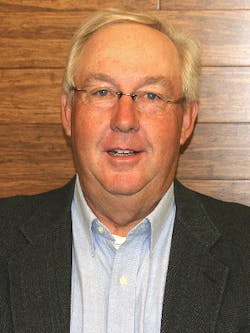We all know the importance of comfort in schools and comfort’s relationship with student performance. While temperature gets the lion’s share of attention, equally important are noise, humidity, and ventilation. Efforts to update standards to address noise, humidity, and ventilation have made it harder for traditional HVAC equipment to establish and maintain comfortable learning environments in schools.
Enter chilled beams.
In a chilled-beam system, zone-based hydronic heating and/or cooling devices complement the primary air ventilation system, enabling the optimization of all heating, cooling, and ventilation functions. Chilled beams are quiet, can reduce energy consumption and maintenance, and take up less ceiling-cavity space while contributing to conditions that increase occupant performance.
Noise
Think back to when you were a kid in math class. There probably were a number of distractions: a class clown, paper airplanes, someone passing notes.
One disruption that does not get the attention it deserves is unnatural or excessive background noise, which studies have shown can significantly hinder student performance. Conventional HVAC systems rarely meet prescribed background-noise-level requirements. ANSI/ASA S12.60, Acoustical Performance Criteria, Design Requirements, and Guidelines for Schools, requires a maximum background-noise level of 35 dBA (about NC 27)—difficult, if not near impossible, to attain with traditional classroom HVAC equipment. Chilled beams do not rely on internal motors or blowers to recirculate and recondition room air and, thus, can be utilized to maintain HVAC background-noise levels in accordance with ANSI/ASA S12.60.
Humidity and Ventilation
HVAC systems that modulate supply airflow rate during occupied operation often do not maintain outdoor airflow rate within the requirements of ANSI/ASHRAE Standard 62.1-2013, Ventilation for Acceptable Indoor Air Quality. Additionally, with all air systems, minimum ventilation airflow rate establishes minimum supply airflow rate. During off-peak operation, this airflow rate exceeds what is required for cooling, necessitating the reheating of supply air before it enters a space.
Active chilled beams served by a dedicated outdoor-air system (DOAS) utilize ducted variable-temperature outdoor air to induce room air through an integral hydronic heat-transfer coil. Classroom cooling/heating demand is met by modulation of the rate of water flow through the coil while the rate of airflow remains constant. The coil’s effect on space conditioning allows ducted-airflow temperature to be reset seasonally, resulting in significant reheat energy savings.
Active beams can be located either within a ceiling grid or floor-mounted adjacent to an outside wall. When active beams are floor-mounted, ventilation air can be delivered to a classroom in a displacement-ventilation manner. This method of delivery can reduce classroom carbon-dioxide levels and the resultant risk of the spread of respiratory diseases by more than 50 percent.
Additional Benefits
Not only do chilled beams benefit students by being quieter and more adept at adjusting to fluctuating humidity and heat conditions, they benefit schools by reducing costs. While most conventional HVAC systems depend on the delivery of large volumes of air to condition classrooms, chilled-beam systems reduce ducted-air requirements by up to 60 percent by relying on their integral heat-transfer coils to offset the majority of space sensible-cooling and heating requirements. And because water is more efficient for space cooling and heating than air, chilled beams use considerably less energy overall than do other options.
In DOAS, chilled beams reduce classroom ducted airflow to the rates required for space ventilation and latent cooling, which allows for a constant volume of ventilation air. Also, they can contribute to the achievement of LEED certification through Energy and Atmosphere Credit 1, Optimize Energy Performance, and Indoor Environmental Quality Prerequisite 1, Minimum Indoor Air Quality Performance.
Conclusion
Despite all of the benefits of chilled beams, schools have been somewhat slow to adopt them. In some cases, this can be attributed to a lack of awareness of and familiarity with chilled beams on the part of architects and engineers. In others, it can be attributed to overblown concerns about condensation.
Today’s schools demand increased HVAC performance at lower costs that meets evolving industry standards. Chilled beams can help schools achieve this because they are quiet systems that are energy-efficient and provide comfort at a reduced cost. All of that adds up to one less distraction for both students and facility managers.
Did you find this article useful? Send comments and suggestions to Executive Editor Scott Arnold at [email protected].
About the Author
Ken Loudermilk
Ken Loudermilk is senior chief engineer of marketing and sales for chilled beams and underfloor distribution products for Titus. With more than 35 years of experience in commercial HVAC, he specializes in educational, health-care, and LEED facilities. He is a member of a number of professional organizations and has held numerous leadership positions, including chairman of ASHRAE Technical Committee 5.3, Room Air Distribution.


